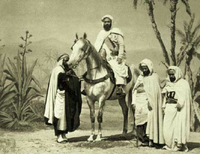
The second Battle of Nördlingen was fought on August 3, 1645 southeast of Nördlingen near the village of Alerheim. France and its Protestant German allies defeated the forces of the Holy Roman Empire and its Bavarian ally.

The Battle of Salamanca took place on 22 July 1812. An Anglo-Portuguese army under the Earl of Wellington defeated Marshal Auguste Marmont's French forces at Arapiles, south of Salamanca, Spain, during the Peninsular War. A Spanish division was also present but took no part in the battle.

Bertrand, Comte Clauzel was a French soldier who served in the Revolutionary and Napoleonic wars. He saw service in the Low Countries, Italy, and Spain, where he achieved short periods of independent command. He became a Marshal of France under the Orléans monarchy following the July Revolution.

The Battle of Beersheba was fought on 31 October 1917, when the British Empire's Egyptian Expeditionary Force (EEF) attacked and captured the Ottoman Empire's Yildirim Army Group garrison at Beersheba, beginning the Southern Palestine Offensive of the Sinai and Palestine campaign of World War I.

Annaba, formerly known as Bon, Bona and Bône, is a seaport city in the northeastern corner of Algeria, close to the border with Tunisia. Annaba is near the small Seybouse River and is in the Annaba Province. With a population of about 464,740 (2019) and 1,000,000 for the metropolitan area, Annaba is the third-largest city and the leading industrial center in Algeria.

The Battle of Isly was fought on August 14, 1844 between France and Morocco, near the Isly River. French forces under Marshal Thomas Robert Bugeaud routed a much larger, but poorly organized, Moroccan force, mainly fighters from the tribes of Beni Snassen, but also from the Beni Angad and Beni Oukil; under Muhammad, son of the Sultan of Morocco, Abd al-Rahman. Bugeaud, attempting to complete the French conquest of Algeria, instigated the battle without a declaration of war in order to force negotiations concerning Moroccan support for the Algerian resistance leader Abd el-Kader to conclude on terms favorable to the French who demanded the Sultan of Morocco to withdraw support for Abd el-Kader.
The Treaty of Tafna was signed by both Abd-el-Kader and General Thomas Robert Bugeaud on 30 May 1837. This agreement was developed after French imperial forces sustained heavy losses and military reversals in Algeria. The terms of the treaty entailed Abd-el-Kader recognizing French imperial sovereignty in Africa. However, the price France had to pay for acquiring recognition entailed its secession of approximately two thirds of Algeria to Abd-el-Kader. As a result of the treaty, France was able to maintain only a few ports.
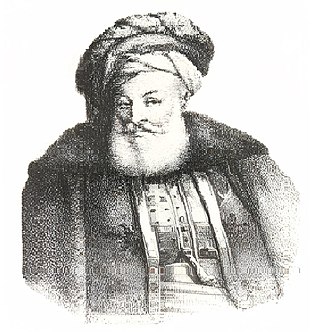
Ahmed Bey ben Mohamed Sherif, also known as Ahmed Bey or Hadj Ahmed Bey was the last bey of Constantine in the Regency of Algiers, ruling from 1826 to 1848. He was the successor of Mohamed Menamenni Bey ben Khan. As head of state, he led the local population in a fierce resistance to the French occupation forces. With the position vacant, in 1833 he adopted the title of leader of Algeria, and dey in exile، although this was not recognized by any other country. In 1837 Constantine was taken by the French after an intense siege. He retreated into the Aurès Mountains from where he continued to wage a low-intensity conflict with tribes still loyal to him, until he capitulated in 1848.
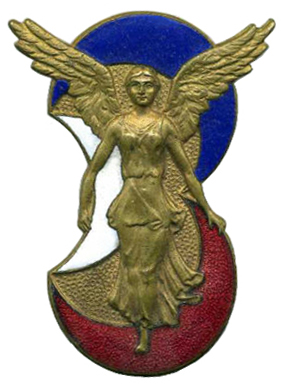
The 3rd Algerian Infantry Division was an infantry division of the Army of Africa which participated in World War II.

At the siege of Burgos, from 19 September to 21 October 1812, the Anglo-Portuguese Army led by General Arthur Wellesley, Marquess of Wellington tried to capture the castle of Burgos from its French garrison under the command of General of Brigade Jean-Louis Dubreton. The French repulsed every attempt to seize the fortress, resulting in Wellington's withdrawal. The siege took place during the Peninsular War, part of the Napoleonic Wars. Burgos is located about 210 kilometres (130 mi) north of Madrid.
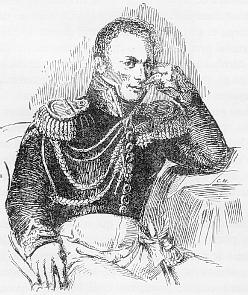
Camille Alphonse Trézel was a French général de division, Minister for War and peer of France during the July Monarchy. He was the assistant chief of the general staff on the Morea expedition, and served in the 1830s in the French conquest of Algeria, where he suffered a disastrous defeat at the Battle of Macta.

The French conquest of Algeria took place between 1830 and 1903. In 1827, an argument between Hussein Dey, the ruler of the Regency of Algiers, and the French consul escalated into a blockade, following which the July Monarchy of France invaded and quickly seized Algiers in 1830, and seized other coastal communities. Amid internal political strife in France, decisions were repeatedly taken to retain control of the territory, and additional military forces were brought in over the following years to quell resistance in the interior of the country.

The 1541 Algiers expedition occurred when Charles V of the Holy Roman Empire and king of Spain attempted to lead an amphibious attack against the Regency of Algiers, in modern Algeria. Inadequate planning, particularly against unfavourable weather, led to the failure of the expedition.

The Battle of Tell 'Asur, also known as the actions of Tel Asur or the Battle of Turmus 'Aya, took place 8–12 March 1918, after the decisive victory at the Battle of Jerusalem and the Capture of Jericho during the Sinai and Palestine Campaign of World War I. Fighting took place over an area which extended from the Mediterranean to Abu Tellul and Mussalabeh on the edge of the Jordan Valley.

The 1837 siege of Constantine was decided by Louis Philippe I and the head of his government, Count Louis-Mathieu Molé, in the summer of 1837. At the time, the consolidation of the July Monarchy and the recovery of economic prosperity, the king was considering dissolving the Chamber of Deputies.

Claude François Ferey, Baron de Rozengath became a French division commander during the Napoleonic Wars. During the War of the First Coalition he fought at Mainz and in the Vendée. After being promoted to command an infantry regiment, he led his unit at Neuwied, Montebello, and Marengo. He led a brigade at Austerlitz in the War of the Third Coalition and Jena, Lübeck, Bergfried, Eylau, Lomitten, and Heilsberg in the War of the Fourth Coalition. While fighting in the Peninsular War, he led a brigade at Bussaco and a division at Fuentes de Oñoro and Salamanca. At the end of the latter battle, his division held off the victorious Anglo-Portuguese forces while the rest of the army escaped. He was killed in this action. His surname is one of the Names inscribed under the Arc de Triomphe, on Column 38.
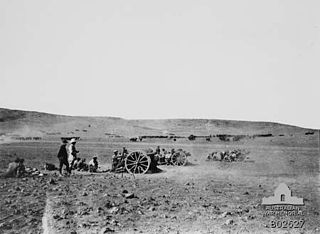
The Battle of Tel el Khuweilfe, part of the Southern Palestine Offensive, began on 1 November 1917, the day after the Egyptian Expeditionary Force (EEF) victory at the Battle of Beersheba during the Sinai and Palestine Campaign of World War I. After the Stalemate in Southern Palestine a series of coordinated attacks were launched by British Empire units on the Ottoman Empire's German commanded Yildirim Army Group's front line, which stretched from Gaza inland to Beersheba. During the fight for the town, the road from Beersheba to Jerusalem via Hebron, was cut just north of the town in the southern spur of the Judean Hills. Here Ottoman units strongly defended the road and the Seventh Army headquarters at Hebron.
The Capture of Wadi el Hesi and the associated Sausage Ridge, began during the evening of 7 November 1917, was fiercely fought for during 8 November and not cleared until the early hours of 9 November, at the beginning of the pursuit phase of the Southern Palestine Offensive in the Sinai and Palestine Campaign during World War I. The advancing British Empire units of the Egyptian Expeditionary Force (EEF) were held by rearguard units of the withdrawing Ottoman Empire units of the Yildirim Army Group, holding a strategically strong position to the north of Gaza.
The Foreign Legion was established in 1831 by King Louis Philippe I to consolidate all foreign corps fighting under French colors, which included, among others, the Swiss Guards, the Swiss regiment of the Royal Guard, and the Hohenlohe Regiment. After its creation, the Legion participated in the further recruitment of foreign nationals into French military service.
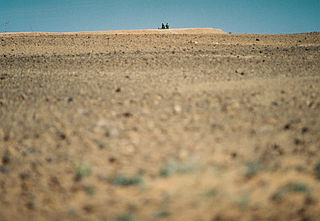
The Battle of Mahbes was fought on 12 January 1985 during the Western Sahara War. As part of its Grand-Maghreb offensive, the Polisario Front, with heavy means, breaks through the wall of sand defended by the Royal Moroccan armed forces.
















